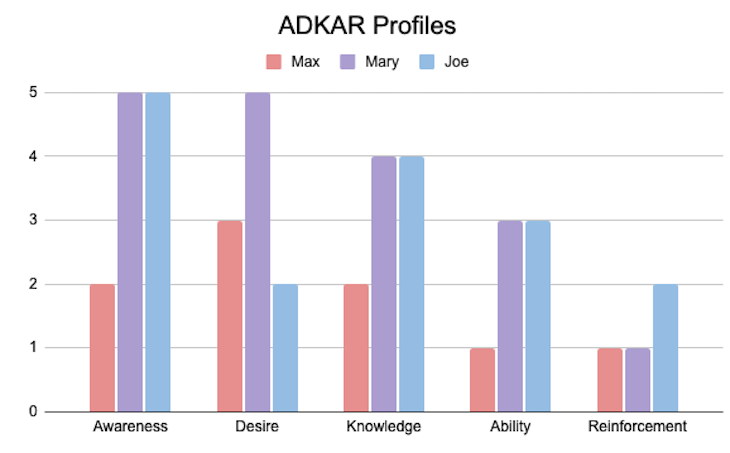The dynamic nature of the business world demands effective change management to sustain a successful product. To implement change within your organization, you need a strategic tool that can help you facilitate processes and deliver on your goals. The ADKAR model structures change through its five stages — awareness, desire, knowledge, ability, and reinforcement.

In this article, you will learn what the ADKAR model is, why you should use it, and how to steer clear of common challenges that can arise.
ADKAR is an acronym for a change management model created by Jeffrey Hiatt. Hiatt developed the model in 1990 after studying common change patterns from more than 700 organizations. The model describes how an individual or a group of people transitions through a change and the acronym stands for: awareness, desire, knowledge, ability, and reinforcement.
Each of these words represents a specific building block that you must reach before you can proceed with the next step. While you need to follow these building blocks sequentially, at any point you can go forwards or backwards, as long as you maintain the same order.
To successfully implement a change you must follow every step in the process. If a step is omitted, you will threaten the change process and inhibit the potential for success.
In order to understand the components of the ADKAR model, let’s examine what makes up each respective part:
According to Prosci, people are most resistant to change because they don’t know there needs to be a change. The problem is less about knowledge or ability and more so that stakeholders lack an awareness of why a change would be beneficial.
Because of this, communicating the need for change is one of the most important things a product manager has to do. Creating awareness for the change goes far beyond the simple announcement of the change. Leaders must be crystal clear about the change and the why behind the change.
Explain the necessity of the change to everyone affected by the change. Everyone must understand the benefits of the change. You can not expect anyone to buy in when they don’t know why it’s happening or what’s in it for them.
Clarify these questions to foster awareness:
It’s not enough to simply communicate these things to employees. Each topic needs to be addressed by the right person in the organization. All information that affects the organization as a whole needs to be communicated by top management and senior leaders of the organization.
All topics which affect the change on a personal level need to be communicated by a direct line manager or a direct leader of the person or group. This includes things like personal requirements, personal benefits of the change, and personal risks of failing to implement the change.
Desire is the hardest element to spark within a person or a group. As a leader, listen to your colleagues to hear if they already have a desire to change.
Sentences like, “I can’t wait to move to the new office,” or “It will be so much easier with the new tool” are strong indicators that there’s a desire to change. But how can you foster desire?
You can only build desire if people understand the need for change. First, you need to build awareness of the change, but just because you build awareness and your employees understand the reasons for the change, it doesn’t mean they desire the change.
Because of this, product managers need to create a dialogue with each person and figure out what they need to build up trust, reduce resistance, and desire change. You need to find out what your employees are afraid of and demonstrate the personal benefit of the change.
This is best done in direct communication.
Do you know how to change? Do you know what you need to implement and sustain the change? These are the questions you need to ask yourself and your colleagues in the knowledge stage of the ADKAR model.
Focus on building theoretical and practical knowledge. As a PM, it is your job to constantly assess the knowledge needs and knowledge levels of the organization and each individual involved in the change process. If you identify gaps, you must enable the team to build the missing knowledge.
This can be done through self-study, video/online training, classroom training, and other forms of training. The gaps might vary greatly between different colleagues. Therefore, it is necessary to address the different gaps and needs on an individual basis.
Use leadership as an enabling agent. Regularly assess the current knowledge and any potential gaps that may exist. The more you know about a topic the more you know what you don’t know.
When it comes to building knowledge, timing is key. Build up knowledge before a person wants to change and you will create resistance, build knowledge too late, and you won’t have the information you need to execute the change.
In the ADKAR model, ability involves putting your knowledge into practice. Be the change and progress onto the next step. You know why to change, you want the change, and you know how to change — now execute the change.
It’s one thing to know the theory and mechanics behind a football game, but standing on the field and playing it is a different thing. Lots of fans can tell you how to play football but almost none of them could play with the professionals.
Encourage your team to start and execute change. As a PM, be there for the team and support them, but don’t stand in the way. It’s best to let the team self-organize.
Foster an environment where learning is part of the daily business and errors and mistakes are seen as development opportunities.
There’s nothing more powerful than habits. If you’ve ever tried to get rid of an old habit, you know what I mean. If you don’t reinforce the change process, old habits can resurface, and all the effort you put into change management can be rendered useless.
When you change the organization or responsibilities of a role these changes need to be lived. If this step is done well, the change becomes a habit, feels comfortable, and is no longer perceived as a change.
However, if you forget or neglect this step, you are back to square one and must begin again to raise awareness and desire for change. To reinforce change, you need to create a system for evaluating performance and creating incentives and disincentives.
As a PM, you should ask yourself what obstacles you can remove to make the change stick. You should monitor the progress of the change, solicit feedback, and acknowledge and recognize short-term successes. Listen to your colleagues and help them overcome pain points.
ADKAR focuses on individuals within change management, but it can also be used for bigger change management processes that aim to introduce an organizational change.
To run a successful ADKAR you need the following roles:
Your goal is to transition individual persons, as well as whole groups step-by-step through ADKAR. Remember that different persons and groups can be in different states. Some may already be ready to execute the transition while others still need to understand why the change is needed.
You can use ADKAR profiles to determine the state of your team members. These profiles can then be used to discuss the situation with the persons involved to find out what improvements you can make.
Here is what such an ADKAR Profile could look like:

To create ADKAR profiles, you simply ask your colleagues to fill out a survey and rate every element of the ADKAR model between zero (not at all/strongly disagree) and five (strongly agree).
Have your colleagues respond to the following statements:
After you collect the profiles via survey or via direct conversation, start a dialog with those who have rated an element below three. First, remove barriers in awareness, then desire, and so on.
From this, you can locate your pain points and determine if there’s any resistance. Then, you can create actionable plans to reduce this resistance and bring everyone up to a three or higher.
If you want to drive organizational change, you have to manage the individual change of everyone involved. We all implicitly apply the ADKAR model in our daily lives.
For example, if you want to learn a new sport, you must first realize that you want to try something new; you must have the desire to start with a new sport like soccer; then you must learn and practice and if you want to stick with the new sport, you must reinforce the sport in your weekly routine.
The ADKAR model empowers individuals by focusing on outcomes rather than tasks. Employees only move through when they have achieved the defined outcome of the building block.
For leaders, ADKAR provides tools and strategies to address each individual and helps them develop the motivation and capability to drive change.
ADKAR alone isn’t a change management process, but it helps you focus on leading individuals and groups through change.
Also, ADKAR isn’t designed for rapidly changing plans. It’s a framework that’s most effective in more established organizations with concrete ideas of what needs to be changed.
ADKAR can be difficult in more complex environments where goals are dynamic and require a more agile approach. Employees need to understand and desire the change, so every time the goal is altered, you are back to square one and need to rebuild awareness and desire.
Because it focuses on the individual level, ADKAR also heavily relies on organizational structures and creates a high communication burden for both direct managers and change managers.
The ADKAR model is so much more than just an acronym. The model mainly focuses on the individual stakeholder level, which has some advantages compared to other change management models, but may result in shortcomings if you want to scale up.
ADKAR is communication intensive and helps to include everyone in the change. This buy-in helps to ensure everyone remains on the same page throughout the process. You can use these steps to help navigate your next change management process.

LogRocket identifies friction points in the user experience so you can make informed decisions about product and design changes that must happen to hit your goals.
With LogRocket, you can understand the scope of the issues affecting your product and prioritize the changes that need to be made. LogRocket simplifies workflows by allowing Engineering, Product, UX, and Design teams to work from the same data as you, eliminating any confusion about what needs to be done.
Get your teams on the same page — try LogRocket today.

A practical framework for PMs to use AI in ideation without sacrificing judgment, strategy, or decision quality.

A practical five minute revenue estimation method to help product managers compare ideas, drop low impact features, and prioritize smarter.

A practical guide for PMs who want to stop being bottlenecks, delegate smarter, and lead teams effectively with a clear ownership framework.

Stop letting unreliable data block features. Treat data as inventory to track quality, ownership, and ship with confidence.